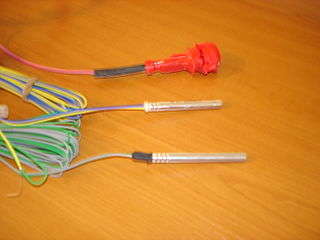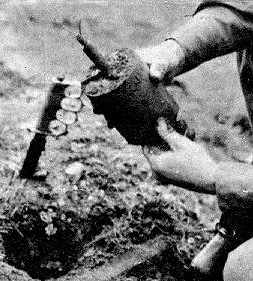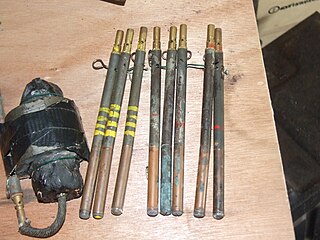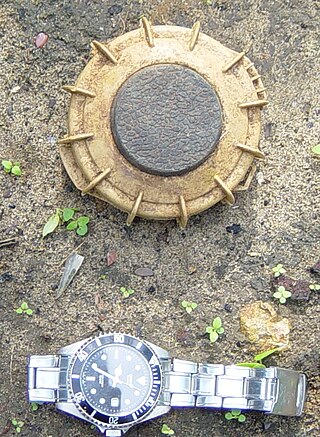| A.P. Mine E.P. No. 4 |
|---|
The A.P. Mine E.P. No. 4 was a landmine used by the United Kingdom and other Commonwealth countries during World War II.
| A.P. Mine E.P. No. 4 |
|---|
The A.P. Mine E.P. No. 4 was a landmine used by the United Kingdom and other Commonwealth countries during World War II.
The mine has a cylindrical container of sheet metal, and a circular lid that is used to store a bounding mine. The bounding mine‘s sides and bottom are made of concrete and shrapnel. [1] In the center of the bounding mine, three sticks of Gelignite act as the mine's explosive element. [1] The mine's trigger is a pressure switch that activates the mine when it is stepped on. [1] (The mine can use any British pressure switch beside the pressure switch E.P. No. 1, which was made specifically for it. [1] ) The pressure switch trigger and the mine are connected through a length of fuse buried beneath the ground, making the fuse invisible. [1] The switch is buried under just enough loose soil to enable a human foot to step straight through the soil, and contact the pressure switch, triggering the mine. [1] The mine's container is buried in a hole with a small amount of loose soil on top making it appear invisible. The pressure switch is also placed under enough dirt to make it invisible to enemy soldiers, but not so much soil that the bounding mine cannot breach the soil when exploding. [1]
The mine is triggered when a separate pressure switch close to the mine is stepped on. [1]
Detonating the mine begins with a compression of the pressure switch, collapsing an igniter ampule in the tube. [1] This lights a connected fuse that burns to the middle, triggering a black powder charge out just under the bounding mine in its container. This sends the bounding mine out of its container into the air. [1] The fuse continues to burn as the mine rises and hits the ground, at which point the fuse burns to its end at the No. 27 detonators, triggering detonation [1] of the mine's three Gelignite sticks. These explode the concrete mine and its impregnated shrapnel, greatly increasing the mine's lethality. [1]
The mine is armed by removing the bounding mine and fuse from the mine container [1] and then inserting the part of the fuse, not meant for the ampule tube, into the pressure switch in the bounding mine's opening. [1] The opposite end of the fuse is then inserted through the mine container opening and the bounding mine is put in its container. [1] The remaining end of the fuse is attached to the pressure switch. [1] Finally, three sticks of Gelignite are put into the bounding mine and the mine trigger device is attached to the bounding mine end of the fuse. [1]
To disarm the mine, the fuse is cut at its connection with the bounding mine [1] and then is disconnected from the pressure switch by its removal from the ampule tube. [1] The fuse is then taken out of the bounding mine. [1] The mine is now disarmed as the fuse that triggers the mine is disconnected from both the mine itself and the pressure switch trigger.

A land mine, or landmine, is an explosive weapon concealed under or camouflaged on the ground, and designed to destroy or disable enemy targets, ranging from combatants to vehicles and tanks, as they pass over or near it.

A detonator, sometimes called a blasting cap in the US, is a small sensitive device used to provoke a larger, more powerful but relatively insensitive secondary explosive of an explosive device used in commercial mining, excavation, demolition, etc.

A pipe bomb is an improvised explosive device (IED) that uses a tightly sealed section of pipe filled with an explosive material. The containment provided by the pipe means that simple low explosives can be used to produce a relatively large explosion due to the containment causing increased pressure. The fragmentation of the pipe itself creates potentially lethal shrapnel.

A booby trap is a device or setup that is intended to kill, harm or surprise a human or another animal. It is triggered by the presence or actions of the victim and sometimes has some form of bait designed to lure the victim towards it. The trap may be set to act upon trespassers that enter restricted areas, and it can be triggered when the victim performs an action. It can also be triggered by vehicles driving along a road, as in the case of improvised explosive devices (IEDs).

Detonating cord is a thin, flexible plastic tube usually filled with pentaerythritol tetranitrate. With the PETN exploding at a rate of approximately 6,400 m/s (21,000 ft/s), any common length of detonation cord appears to explode instantaneously. It is a high-speed fuse which explodes, rather than burns, and is suitable for detonating high explosives. The detonation velocity is sufficient to use it for synchronizing multiple charges to detonate almost simultaneously even if the charges are placed at different distances from the point of initiation. It is used to reliably and inexpensively chain together multiple explosive charges. Typical uses include mining, drilling, demolitions, and warfare.

The German S-mine, known by enemy Allied Forces as the "Bouncing Betty" on the Western Front and "frog-mine" on the Eastern Front, is the best-known version of a class of mines known as bounding mines. When triggered, these mines are launched into the air and then detonated at about one metre (3 ft) from the ground. The explosion projects a lethal spray of shrapnel in all directions. The S-mine was an anti-personnel mine developed by Germany in the 1930s and used extensively by German forces during World War II. It was designed to be used in open areas against unshielded infantry. Two versions were produced, designated by the year of their first production: the SMi-35 and SMi-44. There are only minor differences between the two models.

A pencil detonator or time pencil is a time fuze designed to be connected to a detonator or short length of safety fuse. They are about the same size and shape as a pencil, hence the name. They were introduced during World War II and developed at Aston House, Hertfordshire, UK.

An anti-personnel mine or anti-personnel landmine (APL) is a form of mine designed for use against humans, as opposed to an anti-tank mine, which target vehicles. APLs are classified into: blast mines and fragmentation mines; the latter may or may not be a bounding mine.

The Mle 1939 was a French anti-personnel bounding mine used at the start of the Second World War, it was developed largely in response to the German S-mine bounding mine. It saw very little service before the fall of France. The plans escaped to the US via Major Pierre Delalande, a member of the French Corps of Engineers, and were used as the basis for the American M2 bounding mine which saw wider service during the war but was considered largely ineffective. The M2 mine was replaced almost immediately afterwards with the M16 bounding mine, an almost exact copy of the German S-mine. The French also later produced a copy of the S-mine, the Mle 1951 mine.
Landslide mitigation refers to several human-made activities on slopes with the goal of lessening the effect of landslides. Landslides can be triggered by many, sometimes concomitant causes. In addition to shallow erosion or reduction of shear strength caused by seasonal rainfall, landslides may be triggered by anthropic activities, such as adding excessive weight above the slope, digging at mid-slope or at the foot of the slope. Often, individual phenomena join to generate instability over time, which often does not allow a reconstruction of the evolution of a particular landslide. Therefore, landslide hazard mitigation measures are not generally classified according to the phenomenon that might cause a landslide. Instead, they are classified by the sort of slope stabilization method used:

The Huolongjing, also known as Huoqitu, is a Chinese military treatise compiled and edited by Jiao Yu and Liu Bowen of the early Ming dynasty (1368–1683) during the 14th century. The Huolongjing is primarily based on the text known as Huolong Shenqi Tufa, which no longer exists.
In military munitions, a fuze is the part of the device that initiates its function. In some applications, such as torpedoes, a fuze may be identified by function as the exploder. The relative complexity of even the earliest fuze designs can be seen in cutaway diagrams.
During the Second World War, the Luftwaffe developed a series of unguided rocket-propelled armor-piercing bombs. The three main types were the PC 500 Rs, PC 1000 Rs, and PC 1800 Rs. PC from Panzersprengbombe Cylindrisch the number from the approximate weight of the bomb in kilograms, and Rs meaning rocket propelled. These bombs were intended to be used against armored ships or similar targets. The purpose of the rocket propulsion was to increase the terminal velocity of the bomb and aid penetration.
The Behelfs-Schützenmine S.150 was an anti-personnel mine that was developed by Germany and used by the Wehrmacht during World War II.
The A.T. Mine E.P. Mark V is a World War II British anti-tank mine, an improved version of previous A.T. Mine E.P.-type mines such as the A.T. Mine E.P. Mark II.

The A.P. (anti-personnel) Shrapnel Mine is a British bounding mine of World War II.

The A.P. Mine No. 3 was a British anti-personnel mine of World War II. The mine was developed and produced by the Royal Engineers in India due to a shortage of mines for the Burma campaign. The mine was simpler to lay than previous devices and could be placed by infantrymen, rather than sappers. The A.P. Mine No. 3 was a bounding shrapnel mine that was lethal at ranges of up to 30 yards (27 m).
The A.P. Mine No. 5 was a British anti-personnel mine of World War II.
The Mine A.P. Improvised Type I was a British Anti-personnel mine of World War II.
The Mine A.P. Improvised Type II is a British Anti-personnel mine of World War II